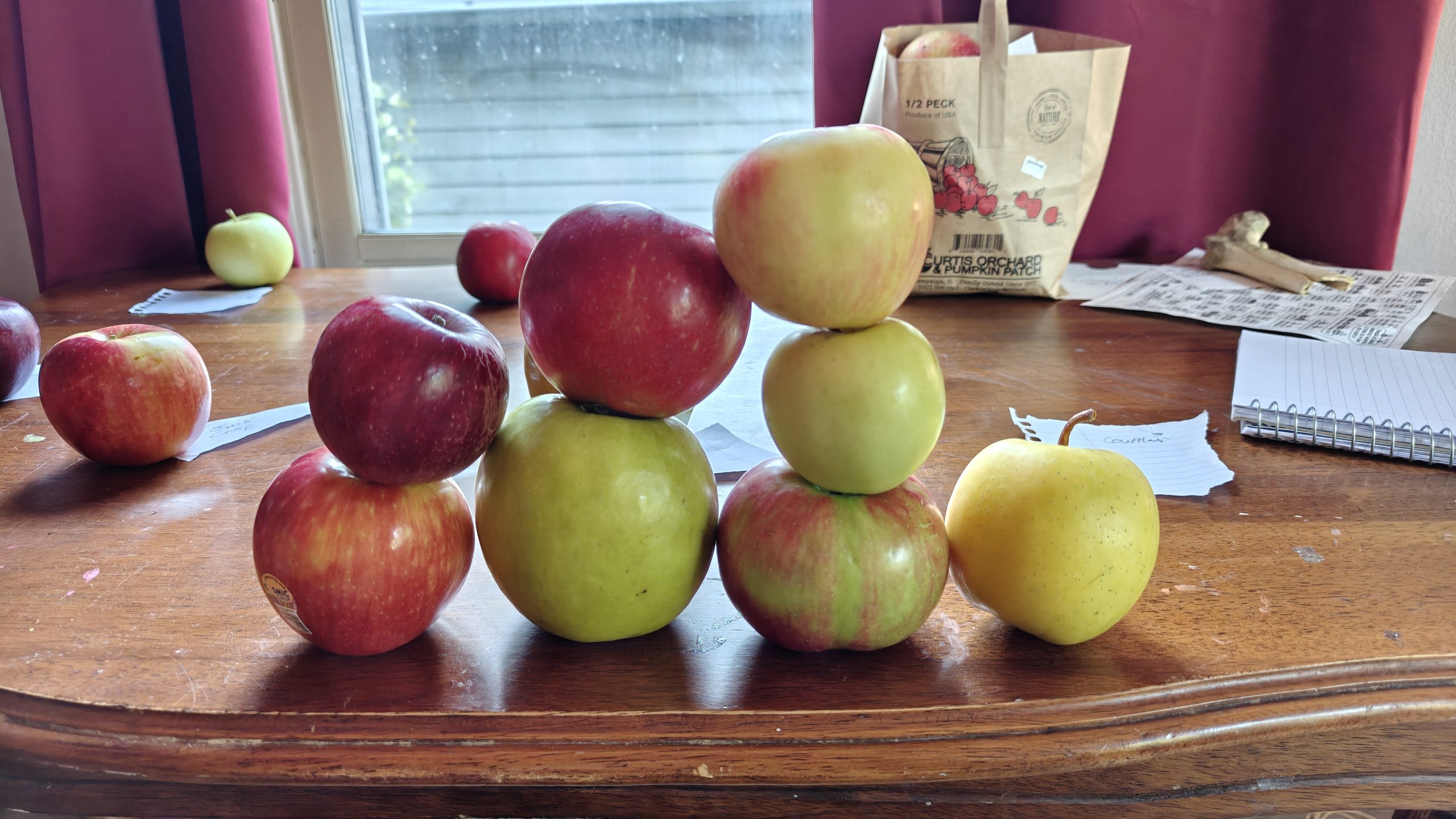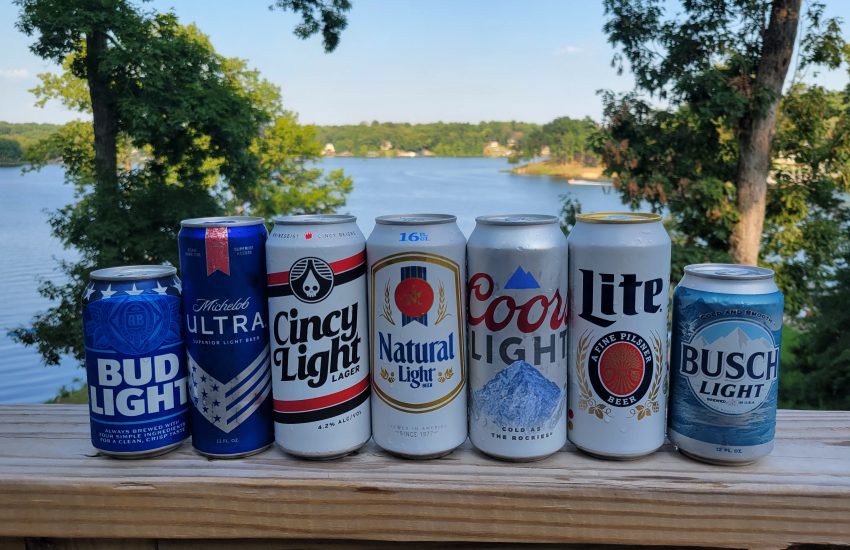Apple Taste Test
Date Tested: September 7th, 2025
Competitors: Cosmic Crisp, Cortland, Granny Smith, Golden Delicious, Jonathan, Honey Crisp, Ginger Gold, Crimson Crisp
Test Description: Blind Tastings: Apples pre sliced and sampled by competitors.
Apples: Mayhap the fruit with the largest variety of flavors, textures, and colors. From pale yellow to crimson red to dark purple. From overly sweet to sour enough to make you pucker. From basically pre-chewed to an audible crunch. What’s up with that? And people just accept it? Most I’ve asked are aware of at least a few apple varieties, but even if they have strong opinions on apples as a whole, few have opinions on the varieties themselves. They might lean towards one or another, but it’s rarely a strong opinion. It’s beyond me how anyone could walk into a grocer, see all the different colors shapes and sizes sitting in their pretty little mounds and just choose at random. How have I dealt with this conundrum, you ask? With crippling decision paralysis, that’s how. And what’s the deal with these super secret apple types you hear whispers of during a full moon? Calville Blanc d’Hiver? Cortland? Opalescent? Crisp to the Core? Smitten? Esopus Spitzenburg? And I only made one of those names up. But where are they hiding? How come I can find gala anywhere but not these supposedly magical fruits? I remember when rumors of the vaunted cosmic crisp reached the Ohio River Valley. “What’s the deal with it?” we all asked ourselves. Well, I guess I can’t speak for everyone. I at least asked myself: Cosmic Crisp but better?! Say it ain’t so! I checked produce sections for years waiting to try it. It was years later that I learned that had bit into, hook line and sinker, the very first PR campaign for an apple. Shows what a sucker I am. I digress – This is all to say that for my entire life I have basically chosen apples at random. And when I choose poorly (*cough* Granny Smith *cough*) sometimes I won’t eat another apple for months. And when I choose well, ill sit there and eat an entire peck (did you know there’s actually an imperial and US customary Peck?) like I’m Captain Barbosa. It’s time to figure this out.
We waited for prime apple season – September, according to my quick google search. The majority of the apples were picked by tasters at Curtis Orchards of Champaign Illinois. And my god do they charge an arm and a leg for that privilege. We picked all apples they had slated as “peak-ripe” plus a pre-picked half peck of perky Honeycrisps.
To round out the selection, a quick stop at the Sapphic grocer up the road netted us the cosmic crisp and granny smith varietals, bringing the total to 8 different apple types. I think we had a good variety of niche and household names. I do wish we had grabbed a gala, but oh well.
The apples were sliced and arranged in a random order to be tasted at one’s leisure.
| Rating | Notes | Apple Variaty | Year and Origin |
|---|---|---|---|
| 9 | Tastes like a pie. Good skin, Soft and pear like texture. Tastes a little cinnimon-y | Golden Delicious | 1905 West Virginia |
| 8 | Tastes like the apples in fruit cups. Great consistency. Light crispy, refreshing. Tastes like fruit punch. | Honey Crisp | 1960s, UMN |
| 7 | Light, Crispy, Juicy, Bitter skin, very good meat | Cosmic Crisp | 2019 Washington |
| 5 | Sour, skin nice, not too bitter. Tastes like green apple candy | Cortland | 1898 New York |
| 5 | A little sour. Very firm. Incredibly red skin. Bitter and juicy. | Jonathan | 1820s New York |
| 4 | Not good! Flavorless. Skin tastes like a leaf. A little too hard. | Ginger Gold | 1980s Virgina |
| 3 | Awful skin. Very "classic apple" taste. Tastes like its been cooked. Big fibers | Granny Smith | 1868 Australia |
| 3 | Bad bitter skin. Not good - too hard and too bitter. Slight tartness. May be ubderripe. | Crimson Crisp | 2004 Rutgers |
This is one of those rare instances where I’m not all that surprised by the results. What I thought was my favorite apple (Honeycrisp) came in second place, and what I was sure was my least favorite (Granny Smith) was tied for last. The test also confirmed my suspicion that the astro-turfed Cosmic Crisp hype is a bit overblown. It’s really not all that different from a Honeycrisp, in fact, you might say that apple didn’t fall too far from the tree. However, the downside of its beautiful dark-purple, white-speckled skin is a slightly more bitter flavor in the peel – something I seem particularly sensitive to and which lost it a point.
Also worth noting is something about the nature of produce itself: fruit and vegetables today are almost entirely unrecognizable compared to those from the year 1900. Nearly everything grown from seed now is bigger, tastier, has fewer seeds, and is available year-round. At least, that’s what they want us to believe. In fact, apples are one of the few fruits where you can still fairly easily find and taste older varieties, thanks to their long-lived trees and the regional pride of their growers. To that end, I had assumed my scores would correlate with the apples’ origin years, but they really didn’t. I ended up ranking old and new varieties all over the place. I wonder if maybe I just didn’t reach back far enough for an old variety, but occam’s razor would suggest maybe my grandparents and their forebears did have access to some delicious apples, they just had poor taste.
There’s not a whole lot more to say here than what’s mentioned in the tabulated notes, so I’ll now share some of the challenges this type of test entails and some more apple facts.
One of the few benefits of ultra-processed foods is consistency. Nearly every Dorito, Big Mac, and Welch’s Fruit Snack is virtually identical. In fact, they’re so reliably consistent that their packaging is oft plastered with some variation of “quality guaranteed.” And they mean it. I’ve sent dozens of emails to Frito-Lay, Kellogg, YUM! and others mentioning a lack of freshness or off-putting colors and gotten no-questions-asked coupons or refunds in return. They can achieve this level of industrial constancy because ingredient lists grow so long, preservatives and flavor enhancers become so prevalent, and production scales become so massive that the law of averages basically guarantees the same thing rolling off the line every time. Fruit and produce don’t have this luxury. Two apples from the same twig can taste completely different. One might be overripe and the other underripe. One might have gotten more sun than its sibling and turned darker because of it. This is to say, there’s a very valid criticism to be made of this test that a sample size of one (one apple, one day, one year, one orchard) isn’t nearly enough to make even a completely opinionated claim such as “Golden Delicious is my favorite apple!” Of course, it won’t stop me from making that claim, but I nonetheless respect the criticism. My orange juice taste test showed this same effect. My main takeaway there was that brand mattered significantly less than where the company was sourcing its oranges at that moment. Another example is the Crimson Crisp in this very test: I thought it was hard and bitter. Those could be traits of that apple – but they’re also traits of an underripe one. What are you gonna do though?
Additional apple anecdotes, for your amusement:
- Every apple you buy is a clone from the original variety. Of course, soil, climate, and season effects taste, but the granny smith you eat is genetically identical to the first one in 1860’s Australia. “New” fruiting trees are grafted from some line of trees leading all the way back to the first.
- The forbidden fruit that the insubordinate Eve so infamously ate is mistakenly attributed to being an Apple because of a mistranslation of malus which meant originally “evil” in Latin and later was given to the genus Malus, of which apples are a part.
- The phrase “one bad apple” is often misused today. The original proverb “one bad apple spoils the bunch” warned that a single corrupting influence can ruin an entire group – just like one bad apple in a peck will start producing ethylene which triggers neighboring apples to start producing more ethylene themselves, thus creating a feedback loop to over ripening. In modern speech, though, it’s usually flipped to mean the opposite: that wrongdoing is isolated to a single individual and doesn’t reflect the group at large.



